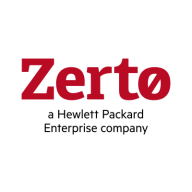


Zerto and Azure NetApp Files compete in the disaster recovery and data management category. Based on feature offerings, Zerto has the upper hand with its robust disaster recovery capabilities and continuous data protection, while Azure NetApp Files shines in performance and integration within Azure ecosystems.
Features: Zerto is known for its disaster recovery abilities, offering low RPOs and near real-time continuous disaster recovery. It easily integrates with VMware environments and allows automatic failbacks, test failovers, and efficient migrations, ensuring business continuity. Azure NetApp Files excels in performance, providing fast backup and restore operations. It integrates seamlessly with Azure services, offering scalable storage and leveraging SnapMirror for replication and SnapLock for data protection.
Room for Improvement: Zerto needs to enhance its documentation and reporting. It also requires better integration with non-VMware hypervisors and improvements in alert systems and licensing flexibility. Azure NetApp Files is perceived as expensive, with users seeking more integration options and regional availability. Streamlining deployment and improving support handling are also suggested improvements.
Ease of Deployment and Customer Service: Zerto is praised for its straightforward setup and effective customer support in on-premises and hybrid cloud environments, ensuring high satisfaction and reliability. Azure NetApp Files, used in public cloud environments, provides good integration with Azure but faces complexity in deployment and support coordination challenges.
Pricing and ROI: Zerto is seen as expensive due to VM licensing costs but is considered worth its price for reducing downtime and resource usage, offering a solid ROI for critical systems. Azure NetApp Files, positioned as a premium service, is higher priced than alternatives, justified by its features and scalability. Effective cost management through scaling and consumption configurations is emphasized by users.
Before, it was a huge cost. It was several thousand dollars to do a DR test, whereas now, I click a button.
The return on investment is evident, as Zerto saves more than 60 percent of time in various operations compared to the previous manual processes.
Most people like me hope we never have to use it. It is like insurance.
They have top-notch people.
I have never had an issue that was not resolved, and I have never been in a situation where they did not respond.
I would give them a rating of ten because it represents the highest level of support based on the technical knowledge of the support team, response time, and effectiveness of the provided resolutions.
We receive support around the clock, which is excellent.
I would rate it a ten out of ten for scalability.
Customers need to follow good engineering practices for optimal product use.
By adding more hosts and installing VRAs on each, tasks can be efficiently managed.
I promptly delete the malfunctioning elements and set them up again to resume replication, ensuring stability.
I consulted with tech support, and we determined the solution was to move the main workload to a resource-available ESX box.
It is 100% stable.
I would like for them to have more compression so that it can avoid using more storage.
If I have 350 objects that I am protecting, I would like Zerto to be able to fire them up in one order, rather than having to manually bring them up in a sequence.
To increase accessibility for small and medium businesses, Zerto should consider a competitive pricing strategy, possibly including subscription-based licensing options.
The main issue with Zerto is its user interface, which lacks flexibility and presents a steep learning curve.
It is expensive, especially with NetApp Ultra Storage.
If you want a good-quality tool that is robust and does a good job for you, you have to pay a higher price to get that, and Zerto is no different.
However, it can become quite expensive when you start looking at the number of workloads you have in the environment and what you would like to do.
Zerto is easier to set up and use, and it's less expensive.
The most valuable feature is that the sixty-terabyte database snapshot can be done in less than two to three minutes.
Zerto offers excellent technical support with responsive and helpful experts.
If we were attacked, I could revert to a backup from five seconds before the attack, and no one would know we were attacked.
The replication time and the minor amount of time it takes to sync a new server outside of any of my huge 40-terabyte boxes is ridiculously quick.



IBM Turbonomic offers automation, planning, and right-sizing recommendations to streamline resource management, improve efficiencies, and optimize costs across virtualized environments and cloud platforms.
IBM Turbonomic is valued for its capability to optimize resource allocation and monitor virtual environments efficiently. It facilitates automated decision-making in VM sizing, load balancing, and cost optimization for both on-premises and cloud deployments. Users can leverage insights for workload placement, ensure peak performance assurance, and effectively right-size across VMware and Azure. The ongoing transition to HTML5 aims to improve visual and navigational ease, while expanded reporting features are anticipated. Opportunities for improved training, documentation, and integrations enhance platform usability and functionality.
What Are the Key Features?In finance, IBM Turbonomic aids in maintaining platform efficiency during market fluctuations. Healthcare organizations leverage its capability for resource optimization during high-demand periods to enhance patient care support. Retailers use it for planning in peak seasons, ensuring resources align with fluctuating demand to maintain performance continuity.
Azure NetApp Files is designed for unstructured data, virtualized SAP systems, SQL backups, NFS and CIFS protocols, Azure Virtual Desktop storage, and optimizing file share services. It supports high performance and networking integration in Microsoft Azure.
Azure NetApp Files offers features such as SnapMirror for data protection, rapid provisioning, elastic scaling, and ultra-fast SQL backup and restore. It provides a seamless experience with fast snapshotting, high availability, security, and ease of setup. Users benefit from significant performance improvements and the ability to manage substantial workload migrations effortlessly. This service is ideal for environments like Azure Kubernetes Service and cloud EPM platforms, where speed, flexibility, and performance are crucial.
What are the key features?Azure NetApp Files is implemented in various industries requiring robust file storage solutions, from educational environments where performance boosts are critical to businesses leveraging Azure Kubernetes Service for containerized applications. It supports high-demand environments, optimizing data management and improving efficiency.
Zerto is used for disaster recovery, business continuity, data migration, and ransomware recovery, providing continuous data protection and near real-time replication. Valued for ease of use, efficient failover processes, and versatile integration, it enhances organizational efficiency, reduces errors, and boosts productivity.
We monitor all Cloud Migration reviews to prevent fraudulent reviews and keep review quality high. We do not post reviews by company employees or direct competitors. We validate each review for authenticity via cross-reference with LinkedIn, and personal follow-up with the reviewer when necessary.